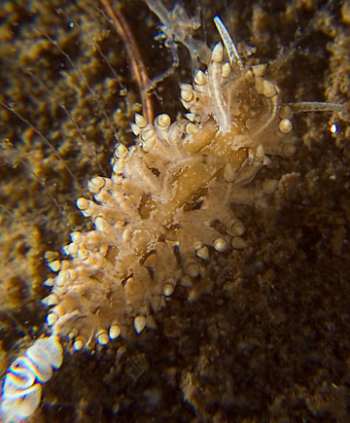
Eubranchus vittatus
(Alder & Hancock, 1842)
Order: NUDIBRANCHIA
Suborder: AEOLIDINA
Family: Eubranchidae
DISTRIBUTION
Known from British Isles, Norway and nthn Spain.
PHOTO
Lephinchapel Reef, Loch Long, Scotland [Sea Loch on west coast of Scotland]. Depth: 14 metres. Length: 20 mm (approx), 21 November 2004. Rocky reef. Photographer: Jim Anderson
Formerly known as Eubranchus cingulatus (Alder & Hancock, 1847). Animal translucent clear with scattered patches of brown and opaque white. On body the brown of the viscera shows through the body wall as well. The cerata have a white band near the tip and a one to three green or brown bands below it. As Bernard Picton states in a separate message [#7187 ], E. vittatus normally has no swellings on the cerata, but a hint of three swellings can appear with darker rings between (hence the name cingulatus). This can be compared with Eubranchus exiguus, which has one large swelling on each ceras, and E. doriae, which has two swellings. The ceratal digestive gland in E. vittatus is white, and visible through the transparent ceratal wall. The smooth tapering rhinophores have scattered opaque white patches in the upper half and a brown or greenish band below. It grows to about 20 mm in length. Picton reports it to feed exclusively on the plumulariid hydroid Kirchenpaueria pinnata, while the similar E. doriae feeds on Kirchenpaueria similis.
-
Alder, J., & Albany Hancock. (1842) Descriptions of several new species of nudibranchous Mollusca found on the coast of Northumberland. Annals & Magazine of Natural History, 9: 31-36.
-
Alder, J. and Hancock, A. (1847) Part 3, for 1846: A monograph of the British Nudibranchiate Mollusca: with figures of all the species. pp. Fam. 1, pls. 6, 8, 19, 25; Fam. 2, pl. 3; Fam. 3, pls. 1a, 7, 19, 28, 31, 33. (The Ray Society: London.)
-
Edmunds, M, & Kress, A (1969) On the European species of Eubranchus (Mollusca Opisthobranchia). Journal of the Marine Biological Association, United Kingdom 49(4): 879-912, Pls.1-2.
-
Picton, B. E., & Christine Morrow. 1994. A field guide to the nudibranchs of the British Isles, 143 pp. Immel Publishing.
-
Schmekel, L. & Portmann, A (1982) Opisthobranchia des Mittelmeeres, Nudibranchia und Saccoglossa. Fauna e Flora del Golfo Napoli, 40: 1-410. Springer-Verlag: Berlin
-
Thompson, T.E. & Brown, G. H (1976): British opisthobranch molluscs. Mollusca: Gastropoda. Synopses of the British fauna (new series), no 8. Linnean Society, London.
-
Thompson, T. E., & Brown, G.H.. (1984) Biology of opisthobranch Molluscs. Vol. 2. Ray Society; London. 1-229.
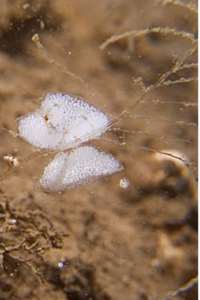
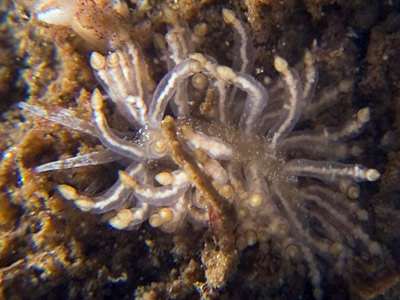
Rudman, W.B., 2005 (January 5) Eubranchus vittatus (Alder & Hancock, 1842) . [In] Sea Slug Forum. Australian Museum, Sydney. Available from http://www.seaslugforum.net/find/eubrvitt
Related messages
Re: First record of Eubranchus vittatus in Norway
August 8, 2005
From: Bernard Picton
Hi Bill,
Sorry to be a bit absent, I got a grant to work on sponges on Rathlin Island and employ someone on the project so have been concentrating on that. We've recently had a new network installed and as we've no dedicated IT staff I get pulled into that as well!!
I think these photos in Kåre's message [#14460] represent two species - the upper one is Eubranchus doriae in my opinion, certainly an interesting find so far North. The others I'd call Eubranchus vittatus which (as you say) I consider to be a senior synonym of E. cingulatus. E. doriae has rings of bumps on the cerata which are clearly shown in this picture, whilst the cerata of E. vittatus have a series of dark rings but are essentially fusiform, like a thin cigar.
Bernard Picton
bernard.picton@magni.org.uk
Picton, B.E., 2005 (Aug 8) Re: First record of Eubranchus vittatus in Norway. [Message in] Sea Slug Forum. Australian Museum, Sydney. Available from http://www.seaslugforum.net/find/14495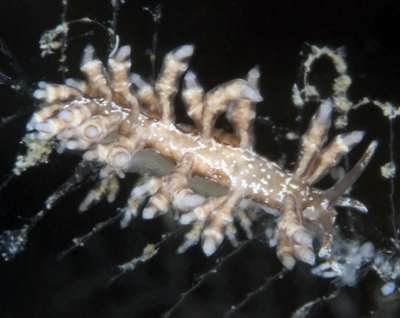
Dear Bernard,
Thanks for the comments. I can see the animal in the upper photo, which I copy alongside, has only the two swellings you mention [message #7187] is characteristic of E. doriae. It looks like she may have two new records from Norway.
Locality: The Trondheim fjord, Norway. North East Atlantic. Depth: 26 meters. Length: 1 cm. 25 July 2005. Rocky, current exposed. Photographer: Kåre Telnes
Best wishes,
Bill Rudman
Re: First record of Eubranchus vittatus in Norway
August 3, 2005
From: Jussi Evertsen
Hi Bill, and Kaare.
Concerning message #14460: The reason I used Eubranchus vittatus and not Eubranchus cingulatus, is that the descriptions given by Alder & Hancock in their monograph (both are described and illustrated in there), best fits E. vittatus. The rarity of a species is not nescessarily true, that we time and time again see here in Norwegian waters where divers just recently have started looking for nudibranchs. In Brown (1980) they are kept as separate species, but characters do overlap. Alder & Hancock separate the species on the shape of the cerata (they are clavate in E. vittatus and ovate in E. cingulatus, and that E. vittatus has wrinkled rhinophores, whilst E. cingulatus is supposed to have smooth ones). I was fortunate enough to get 7 specimens from Kaare, from 5 to 20 mm in length. They had a translucent body with superficial light and dark brown pigmentation on the dorsal side in a patchy manner all the way down to the tail (the smallest specimens being the lightest in colour). White minute dots formed lines and blotches on the body. The cerata were club shaped (as clavate in Alder & Hancock), meaning they were more or less sylindrical in shape, but expanding towards the apex. They were set in 8-10 rows, with max 8 cerata counted in the foremost row. The cerata had white caped tips with a tinge of gold, and three distinct brown bands. The rhinophores had white pigmentation from the tip and maybe 1/4 down, had a brown band, and where wrinkled from the basis half way up, the wrinkling being more distinct in the bigger specimens. The oral tentacles were shorter than the rhinophores and smooth, with white tips and a brown band.
From the literature, Edmunds & Kress (1969) and Thompson & Brown (1984) all keep them as separate species, and as long as there has not been done a thorough investigation, we are but to consider all species available. These specimens happens to fit Alder & Hancock's (1852) description.
Jussi
jussi.evertsen@bio.ntnu.no
Evertsen, J., 2005 (Aug 3) Re: First record of Eubranchus vittatus in Norway. [Message in] Sea Slug Forum. Australian Museum, Sydney. Available from http://www.seaslugforum.net/find/14464Dear Jussi,
This species is one of the probems which still arise from early descriptions based in very few animals. We can concentrate on the particular features of a single specimen or try an envisage how the description of a sinmgle specimen relates to variation within a population. Thompson & Brown (1984) consider there are problems with earlier identifications of what they call E. cingulatus, noting that Schmekel & Portmann's (1982) account referred to E. doriae, and so possibly did Edmunds & Kress's (1969). They also note that they had earlier done the same (Thompson & Brown, 1976: Fig 89). Why I mentioned rarity is that Thompson & Brown's (1984) description of E. vittatus was based on a single specimen, so they had no opportunity to compare living populations of the two nominal species and see just how much variability occurred.
Hopefully Bernard Picton will have a moment to comment on this
Best wishes,
Bill Rudman
First record of Eubranchus vittatus in Norway
August 2, 2005
From: Kåre Telnes

[Note added 8 August: see Bernard Picton's message [#14495] suggesting the upper photo is Eubranchus doriae ]
This summer I have at two occasions found Eubranchus vittatus in Norway. Jussi Evertsen at the university in Trondheim has received specimens and confirmed the identification. So I guess I can regard this as the first record in Norway. It is known in Scotland, which is not too far away. I am a bit confused though, as Jussi mentioned another species, E. cingulatus. At the Sea Slug Forum E. cingulatus and E. vittatus are regarded as a single species, while Jussi, along with the European Register of Marine Species, regards these as separate species. Could you clarify this, please?
(More pictures here: http://www.seawater.no/fauna/Blotdyr/vittatus.htm )
Locality: The Trondheim fjord, Norway. North East Atlantic. Depth: 26 meters. Length: 1 cm. 25 July 2005. Rocky, current exposed. Photographer: Kåre Telnes
Kåre Telnes
kare@seawater.no
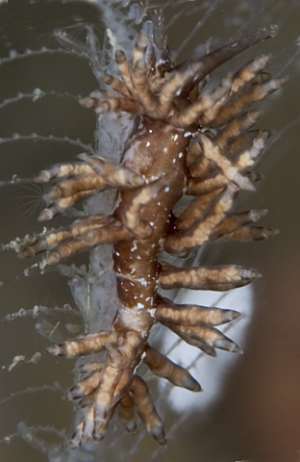
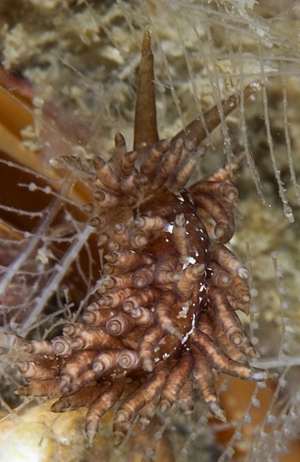
Dear Kåre,
Thanks for this interesting record. Most occurrences of this species have been from the northern part of the British Isles suggesting it is a colder water species, so your find certainly fits that idea. Concerning the names E. cingulatus and E. vittatus. Both species were described by Alder & Hancock from the UK, but one of them - E. vittatus - has been considered very rare, Thompson & Brown (1984) reporting only 3 records since its description in 1842.
As I mention on the species Fact Sheet, I follow Bernard Picton, who probably has the best knowledge of this fauna as living animals, in considering E. vittatus and E. cingulatus to be the same species. It may seem surprising that in such a populated part of the world, we still have identity problems with the marine fauna, but I guess its all a question of priorities for science research spending. With the space shuttle aloft at present it is perhaps timely to mention Cape Canaveral again. It troubles me that we spend so much to look for life on Mars etc., and almost nothing to look at life in the Gulf of Mexico.
Best wishes,
Bill Rudman
Eubranchus vittatus from Scotland
January 5, 2005
From: Jim Anderson
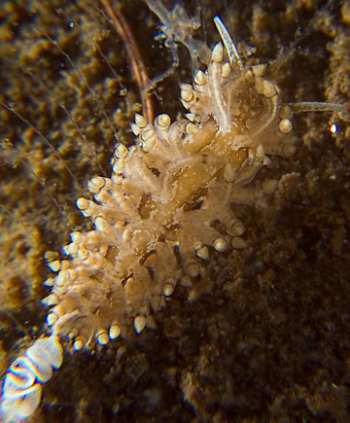
Dear Bill,
Welcome back.
When time permits you may wish to add the accompanying images and info on Eubranchus vittatus to the Forum. Both animals and spawn were found within 250mm of one another. Water temperature 11 deg C. The ID's were confirmed by Dr. Bernard Picton.
Locality: Lephinchapel Reef, Loch Long, Scotland [Sea Loch on west coast of Scotland]. Depth: 14 metres. Length: 20 mm (approx), 21 November 2004. Rocky reef. Photographer: Jim Anderson
Kind regards,
Jim A
jander4454@blueyonder.co.uk
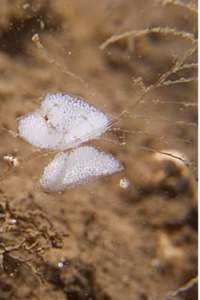
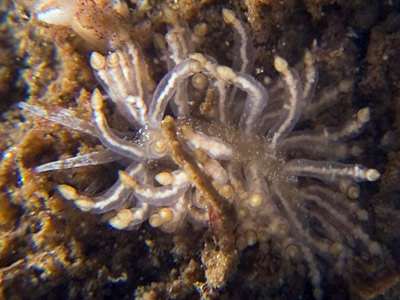
Dear Jim,
Thanks for this new addition to the Forum. It's nice to fill in some the gaps especially among the troublesome species of Eubranchus in the Nth Atlantic.
Best wishes,
Bill Rudman
